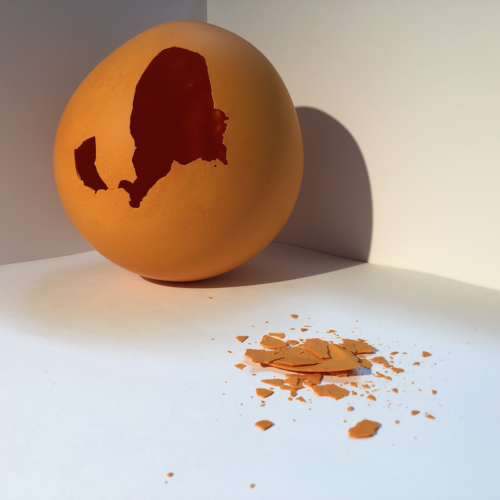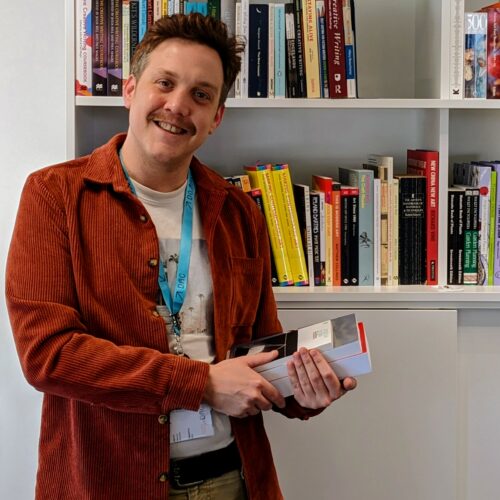
OCA new course: Material and Making: Approaches to Sculpture

Relative to some disciplines, Sculpture is often seen by students as less accessible than many subject areas. Restrictions on space, expectation of scale, access to appropriate materials and technologies, are all legitimate and understanding limitations for many. As unit leader for Sculpture 1; Starting out in 3D, I’m keen to address these issues and promote the diverse and multidisciplinary aspects the discipline now occupies, seeking to enable a range of methods and approaches to three-dimensional work that functions in an accessible and ethical manner.
Taking a broad view of what a three-dimensional practice may consist of today, Doug Burton and I recently co-authored ‘Material and Making – Approaches to Sculpture’. This new foundation course introduces various key methods for material investigation, through approaches to making that challenge students to navigate, explore and respond to their three-dimensional environment. We encounter a vast range of materials and objects in our daily lives and this course enables students to exploit the materiality around them in creative ways, forming transferable skills for further study in different areas, primarily Creative Arts and Fine Art pathways.
Using materials close at hand and easily accessible, the course helps develop an investigative approach to making, building key creative and technical skills, alongside visual and contextual awareness of recent sculptural history. Foundation courses can be transformative for students looking for a change of direction or wanting to diversify their creative output. This course promotes invention and exploration through making to challenge expectations and develop a personal student voice.

The course is structured into five sections, each focused on particular transferable methodologies; Assemble, Modular, Tension, Scale and Shaping. Students are introduced to a range of manageable three-dimensional exercises and projects, alongside being encouraged to explore mark-making, drawing, mixed media, photography, installation, video and textiles processes on the journey.
(from course intro)
- Part One: Assemble, aims to initiate you into the act of collecting together materials from your immediate environment and make an ‘assemblage’ of ideas. The importance of each object and the way it locates itself is key to the beginning of this part. Artists today have an unlimited range of materials and objects to make work with. There are many tools and methods you can use and these exercises will help you relax into using and discovering potential around you.
- Part Two: Modular, looks at the work of Tara Donovan, David Mack and Shirazeh Houshiary. You are asked to make a free-standing sculpture that uses an easily available module (e.g paper clip, cereal box, coat hanger) that can be obtained in abundance and use the act of repetition to initiate and maintain a process of making.
- Part Three: Tension, considers the relationship between objects and space, creating a range of works that explore gravity and balance. Artists that inform this topic include Roman Signer, Fischli and Weiss and Alexander Calder. This approach to making considers these materials as part of a collage and aims to stretch the imaginative outcomes and undermine the preconceived.
- Part Four: Scale, involves making substantial work from small beginnings. Looking at the work of artists using different scales in a variety of contexts, you will develop observational skills and consider where to locate your work and how to install it.
- Part Five: Shaping, looks at the work of Gabriel Orozco ‘From my hands are my heart’, this final part aims to integrate the body into the act of making using clay as a material to transfer the touch and surface into the act of forming an object. This final part will give you the opportunity to think about your next steps as an artist and student.

https://www.oca.ac.uk/our-courses/foundation-courses/
Further to the introduction of this new OCA foundation course, the Sculpture 1: Starting out in 3D and Sculpture 2: Developing Autonomy degree course units have recently had significant updates and are in the final stages before release. It is hoped these updates form continuity across levels and expand upon the diverse possibilities sculptural practice has to offer students at OCA in the future.
https://www.oca.ac.uk/subject-areas/sculpture/
|
|







Excellent and personally very interesting! However, how do you take the course? Do you have to take this as part of a degree course?
I would like to know how to enrol in this class. It doesn’t seem to be listed in your prospectus.
Hi Gilly, this foundation course is brand new, hot off the press, there’s more information on the website under the foundations tab, hope to see you there.
Hi Peter, thank you for your interest in this course. It’s a foundation course that consists of five parts and five pieces of tutorial feedback. if you’re interested you can see the learning outcomes on the OCA website. Hoping to see you there. Doug
I should add, you don’t need to be part of any degree course to do this foundation, equally if you’re on a degree and fancy doing this foundation to enhance your studies that is equally fine.
I have the same questions Mr Horsburgh does. Fascinating course as it sounds. Look forward to reading the response. Thank you.
Thanks Yurena, it was a joy to put together with Adam, really looking forward to tutoring it. Hope to see you there, Doug
This course looks brilliant! Can you tell me when the updated Sculpture 1: Starting out in 3D will be released please? Thanks, Claire
Hi, wondering if someone could reply to my question above asking when the updated Sculpture 1: starting out in 3D will be released, please? Or is it available now? Thanks.
Hello Claire,
I believe this has been updated and is available now.